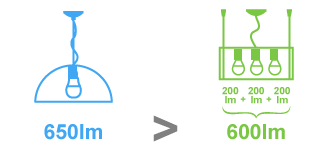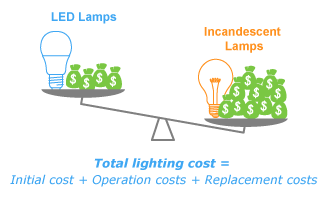Myth 1: Lamps with higher wattage implies higher brightness.
Fact: Lumens (instead of wattage) of LED bulb represent the sum of all the light emitted by the bulb. The higher the lumen value, the brighter the bulb.

Many people think that higher wattage implies brighter lamps. This is not always true. For example, a 100-watt incandescent lamp is brighter than a 20-watt lamp, but it may not be brighter than a 20-watt LED lamp. Incandescent lamps use the same filament material heated to the same temperature, and the only way to increase their light output is to increase wattage. However, in the world of LED, efficacy (efficiency of light output) counts. The efficacy of incandescent lamps is much lower than that of LED lamps due energy wastage to heat.
To determine brightness, we should look at lumen, instead of wattage. If the wattages of two lamps are identical (which means they consume the same amount of power), an LED lamp can produce five times more light than the incandescent lamp.
Myth 2: An LED lighting fixture with more light bulbs will have higher lumen in total than another with only one bulb.
Fact: One LED light bulb with high lumen will be as powerful as or more powerful than many LED light bulbs added together.

When you are buying a lighting fixture with LED bulbs, you may be told by the sales assistant to choose those with more LED bulbs as they produce brighter light source than those with only one bulb. This is not totally true. Let’s apply the same thinking as the first myth. We should look at lumen rather than the number of bulbs, as more bulbs does not necessary deliver higher lumen value. One piece of high-quality LED bulb with higher lumen value and low wattage can be much brighter than three pieces of low-quality lamps with lower lumen value and high wattage.
Myth 3: LEDs are very expensive and unaffordable.
Fact: Let’s look at the return-on-investment in the long term and the total lighting cost. You’ll find it is worth investing in an LED than a traditional lamp for sure.
The initial cost of purchasing an LED lamp will balance out the total lighting cost in the long-run. Let’s look at this simple equation, which applies to all types of lighting solutions including traditional lights:

Bear in mind that LED lamps have lower energy consumption (85% less) and longer life span (50,000 hours) than the incandescent or halogen counterparts. The significant saving in energy bills and replacement costs for an LED lighting solution will offset the initial lamp cost gradually. Therefore, the total cost of LED lighting is actually much smaller in the long run. And normally, the payback on an LED lighting solution can be realised in less than three years.
Myth 4: LED lamps can last forever.
Fact: LED lamps have an exceptionally longer lamp life than traditional lamps. However, they will still fade out over time yet at a slower rate.

Like all light sources, LED lamps fade slowly over time. The factors that cause lumen depreciation include drive current and heat generated within the device itself.
Lumen maintenance describes how long a lighting fixture retains a certain percentage of its initial light output. White light sources used for general illumination are commonly considered to be at the end of their life when their light output falls below 70% of initial output. With continuous use for 8 hours a day, a well-designed LED lighting fixtures can operate for over 17 years – much longer than incandescent sources (some only last for just a few months).
Myth 5: LED lamps don’t give off any heat.
Fact: LED lamps do not give off any radiant heat, but they do need to get rid of conductive heat in order to achieve long lamp life.

LED lamps are really “cool” to see and touch! They do not give off radiant heat in the direction the light being dispersed, thanks to its embedded heat sink design, which is a method of thermal management which provides a path for heat from the LED sources to dissipate to outside medium. As a result, heat emission by LED lights is less than that of halogen lights, which contributes to a cooler environment. With the advancement of technology, LED lights will be more efficient in terms of light output per unit of energy, and emit very minimal heat in future.
Myth 6: LED lamps contain higher proportions of blue light which are likely to be hazardous.
Fact: LED lamps are safe to the consumers when used as intended, according to the European Lighting Industry represented by ELC & CELMA.
It is said that LED based light sources are different from traditional lamps in that they contain more blue wavelength light which is harmful to human beings. According to an evaluation report by the European Lighting Industry represented by ELC & CELMA, in terms of their level of photo biological safety, LED lamps are no different from traditional incandescent lamps and fluorescent tubes. The portion of blue in LEDs is no difference from the portion of blue in lamps using other technologies at the same colour temperature.
All high-quality LED products are strictly designed to meet a photo-biological safety standard, which is IEC 62471, to ensure human eye safety. At MEGAMAN®, all of its LED products have undergone stringent optical safety test in accordance to the requirements of IEC 62471 to ensure a healthy, harmless and comfortable light source for customers.


 top
top